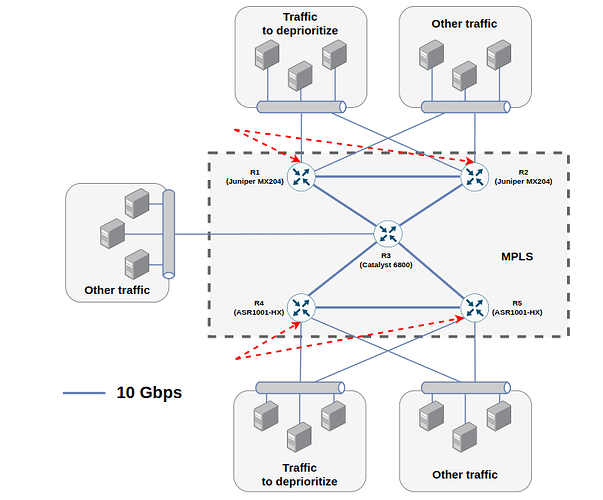Hello Trif
First of all, we must remember that QoS has several distinct operations. One is classification and marking, which has to do with identifying certain types of traffic and setting or changing their DSCP values, while the other is employing QoS mechanisms that act upon those markings (queuing, shaping, policing etc…). Note at this point we’re talking only about Layer 3 QoS which involves the ToS field of the IP header.
An excellent description of how this works is found in RFC2475 and I’ve included the diagram below:
+-------+
| |-------------------+
+----->| Meter | |
| | |--+ |
| +-------+ | |
| V V
+------------+ +--------+ +---------+
| | | | | Shaper/ |
packets =====>| Classifier |=====>| Marker |=====>| Dropper |=====>
| | | | | |
+------------+ +--------+ +---------+
Fig. 1: Logical View of a Packet Classifier and Traffic Conditioner
Let’s ignore the “Meter” for now. Packets will be classified, marked accordingly, and then either shaped or dropped depending upon various set conditions.
Now as far as the interpretation of those markings goes, there are specific predefined approaches, which are further described in the IP Precedence and DSCP Values lesson. Various DSCP values are associated with specific traffic types and default treatment of those types, but keep in mind that you can change that behavior to whatever you like. There are specific definitions to commonly used DSCP values, but you don’t necessary have to use those, you can change them and create your own.
So if you want to achieve what you describe, simply mark the packets you want with a particular DSCP value that is not being used, such as CS1 for example (which corresponds to a binary value of 001000). Once you mark your traffic, you can then create the policy you want to drop those packets.
But you must be aware, many devices have default settings for how to deal with specific DSCP markings as far as QoS goes. Be sure that the value you choose is not being used anywhere else in your network, and that the default behavior of your specific routers is not acting upon that particular value in an unwanted way.
In theory, you can have up to 64 different traffic classes since the DSCP field is composed of six bits. However, QoS RFCs recommend but do not require, specific values and encodings to be used, and that is why we have various definitions such as DF, EF, AF, and CS. But ultimately, you as a network admin have full flexibility to define traffic classes as you see fit, so you have the power to override the default behaviors.
I hope this helps you in your specific design and answers your questions about the CS1 DSCP value. If you have any further questions, or get stuck along the way, let us know!
I hope this has been helpful!
Laz
